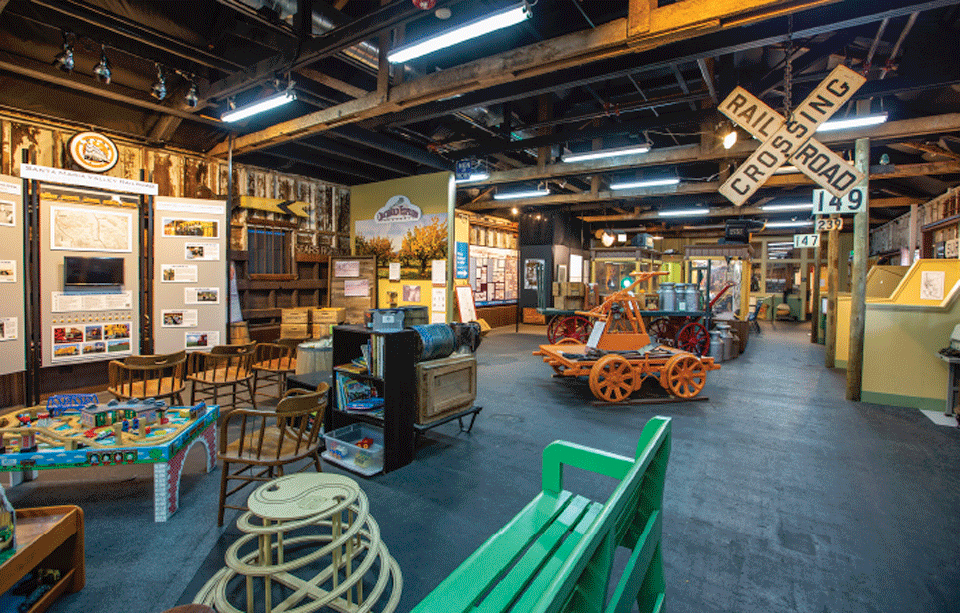Thanks to the city of San Luis Obispo and a dedicated group of rail lovers whose efforts extended over decades, the 1894 Southern Pacific Freighthouse has been completely retrofitted as a modern-day railroad museum. Visitors can take a trip back in time as I did recently with museum docents, John and Diane Marchetti and Andrew Merriam. The Freighthouse can be seen adjacent to the tracks not far from the now famous life-size bronze statue depicting Chinese railroad laborers.
When Diane retired from teaching, the Board offered her the job of Museum Manager. “I was told the hours would be flexible, the work fascinating and the pay … well, there was no pay. I took the job and have loved it ever since,” said Diane with a grin as she took me on an amazing 90-minute tour of the facility.
Working with the city of San Luis Obispo, various construction companies, and railroad historians, the Museum’s architects and building committee began restoring, creating, and enhancing a piece of SLO’s history we might have lost to time. It all began with the Pacific Coast Railway, which ran three-foot gauge rails from Avila to SLO to Los Olivos. Much of the freight was brought in via the Pacific Coast Steamship Company. After all, in 1873, it would take a week to travel by stagecoach to San Francisco or Los Angeles; plus, one would have to perilously contend with unpredictable weather (torrential rains, flooded creeks, etc.), robbers, and bone rattling terrain. The Southern Pacific arrived in SLO in 1894; by 1901, standard gauge rails had been laid from Los Angeles to San Francisco and travel time was cut to about a day, which is about the time it takes to traverse the 430 miles today by train.
“Around World War II, the Southern Pacific Railroad employed up to 15% of all workers here in SLO,” stated Andrew. “The railway station was a gathering place where up to 1,000 people could be found at any one time,” added John.
Here in the Freighthouse is where many of the materials brought and shipped would be weighed, measured, and recorded,” pointed out Diane. “Building materials, oil, grains, milk cans, sugar beets, beans, vegetables, and other crops would be weighed right here where we stand, and over there … mounted on the wooden platform sat the original scale. You can still see the mountings for it.”
When I inquired about the scale, Diane and John just shook their heads. “It disappeared some years ago. We hope you will mention it in your article, for we would love to have it returned—no questions asked. We believe it is probably still in SLO somewhere—probably getting dusty in some barn or cellar.”
Another local railroad is the Santa Maria Valley Railroad—established in 1911. In the early 1900s, with motorcars gaining in popularity, the railroad began to lose money. Fortunately, in 1925, Captain Allen Hancock (Hancock College’s namesake) purchased the failing railroad at auction on the steps of the Santa Barbara Courthouse. Soon after, he began to develop different industries in and around the Santa Maria Valley and made the railroad a great success. After Captain Hancock passed away, his family took over ownership of the company. Eventually, the family decided to sell the railway to a local man, Rob Himoto, who had the same dream as Captain Hancock—keep the little short line running.
Thanks to the hard work of Rob and his family, the railroad became a successful business and continues to benefit the Santa Maria Valley. While Diane explained the significant part the railroad played in making SLO County a thriving community, John called me to see another large section of the museum. I walked into a world of Lilliputian wonder where dedicated artists had creatively constructed a miniaturized railway replica that included people hanging clothes beside the railroad tracks, reconstructed whistlestops, mini-replica hotels, and detailed piers—the SLO scene of minutiae played out before me.





